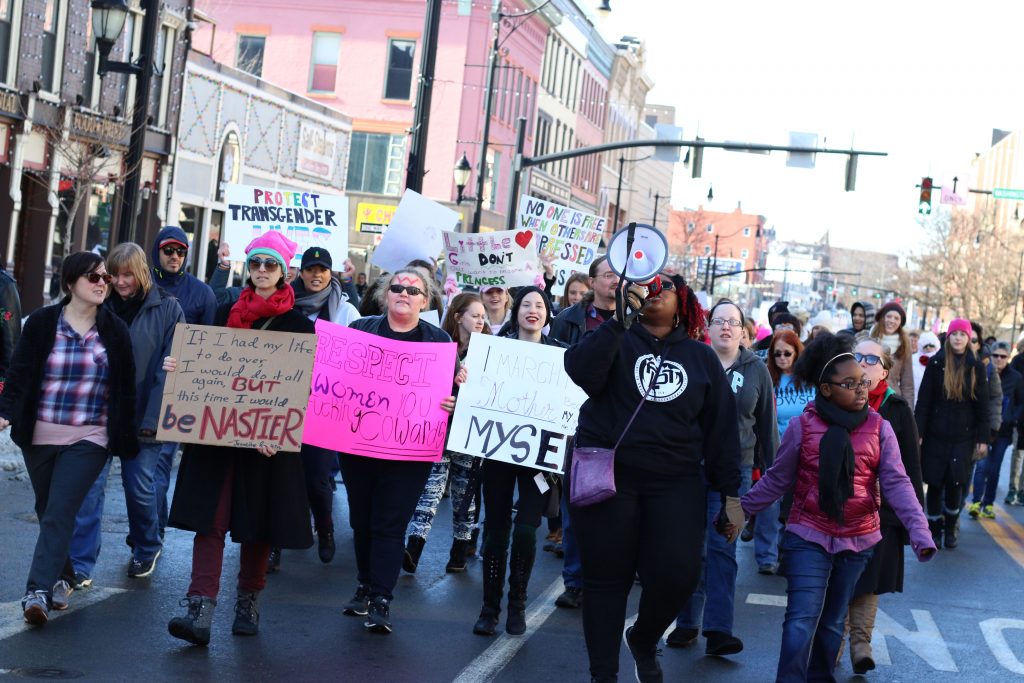
Raising signs and shouting chants, residents of the Binghamton area joined people of cities throughout the country to protest President Donald Trump’s administration at the 2018 Women’s March on Binghamton this Saturday.
More than 1,000 men and women congregated at the Martin Luther King Jr. Promenade in Downtown Binghamton and marched to United Presbyterian Church of Binghamton at 42 Chenango St. carrying signs that read, “Boys will be boys held accountable for their actions,” and “A woman’s place is in the resistance.” The crowd chanted “Women’s rights are human rights,” “Black lives matter” and “The people united will never be defeated,” as a part of the march’s theme, “Be Heard.”
The march was organized by the city of Binghamton and the Southern Tier Chapter of Citizen Action of New York, a grass-roots organization that aims to dismantle various institutional forms of oppression including racism and sexism.
Shanel Boyce, the Citizen Action community organizer for the city of Binghamton and a second-year graduate student studying social work, said that the Women’s March is a necessity in today’s political climate.
“We realized that the Women’s March is a call to action, and it’s also about unity,” Boyce said. “A lot of times, people need spaces and people to surround them so that they can plug back in and recharge and there is nothing better than marching with hundreds of women and men and allies that are supporting the same cause that you do.”
Boyce said that while the event was considered a success, some issues arose during the planning stage. Citizen Action sent out a notice to its supporters that some responded to negatively. The notice urged the participants to refrain from engaging with police officers and to not practice exclusive advertising that could leave out the LGBTQ community, specifically transgender individuals.
According to Boyce, nearly 3,000 people showed up for last year’s march, but she was unsure how many people attended the event this year.
“I was cautiously optimistic for 500 people, but I am happy to admit that I was wrong,” Boyce said. “It shows that people are ready for change and that allyship is real. We chose that we were going to make sure that our women of color had the floor and that trans folks knew that we supported them and that we make a civil call against police brutality.”
Rachel Russo, a sophomore majoring in systems science and industrial engineering, said she hadn’t attended last year’s march, but felt it was important to attend this year.
“I feel like our president treats women like garbage and I think that it’s very important that we stand together as women to take back the rights that we deserve,” Russo said. “The fact that Donald Trump is saying so many negative and sexist things and that people are agreeing with him and supporting him and actually using it as a way to justify their beliefs, that really is a huge problem.”
Because of the large turnout, the speaking part of the event took place in the main area of the church, where people filled the pews, both balconies and even the aisles. Speeches focused on educating the audience on the topics of sexual assault, human trafficking, transgender and reproductive rights, immigrant rights and intersectionality.
State assemblywoman Donna Lupardo gave one of the first speeches, noting how far the Women’s March movement has come since its first iteration last year.
“We were so worried with what we were going to face with this presidency, but here we are one year later at the second Women’s March while the government is shut down,” Lupardo said. “We have not lost our ability to resist. We have not lost our ability to turn this moment into a historic movement. And we have not lost our ability to hope.”


